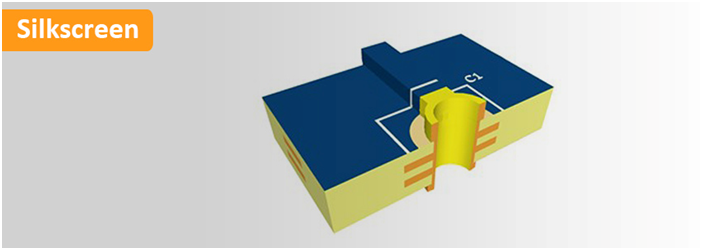
Most Printed Circuit Boards have a component legend to show which component goes where to placement. Silkscreen is normally to identify components, test points, PCB and PCB Assembly part numbers, warning symbols, company logos and manufacturer marks. It is common to have Silkscreen required for the solder side.
How to Print Silkscreen?
You need to know the work required to produce two Silkscreen is simply twice as much as one side printing. PCB Silkscreen requires specially formulated inks. Standard colors are black, white and yellow. Non-standard colors can be requested but will impact your cost and lead-time. Why? Generally, these non-standard colors are not commonly required and need take time to source such inks. If the sourced non-standard colors do not be used out in your PCB Fabrication, they will be expired soon counting in hours.
At one time, PCB CAM software allowed for a few standard fonts on PCB surface to be used in silkscreen layers. Now, many packages allow for all available system fonts to be used. Be careful when choosing your font. PCB Manufacturers are required by IPC to provide both a manufacturer’s mark and an identifier which will allow for lot tracing should problem occur. Although there are no strict standards for where these markings appear, PCB manufacturers will generally try to place them in non-critical areas. But just because you know the PCB Board will also double as a backlit equipment faceplate with your company logo doesn’t mean your PCB manufacturer will. If you require these markings to be placed in a specific area or omitted, you need to specify it in the PCB readme.txt file, in a fabrication drawing or in your communications with the PCB manufacturer. We prefer to place our logo and date code (WWYY) on an Silkscreen layer.
Silkscreen Printing is done when the PCB boards are still panelized prior to the application of the final finish or routing or V-cut. We do have a minimum size of 8mil line width for all lettering and graphics. If you have a requirement for Silkscreen printing, just let us to be informed. Some parameters of PCB Silkscreen Printing to be considered include viscosity of the ink, room temperature, humidity, age of the ink and hardener and line resolution. From these variables the correct amount and distribution of ink is derived and even the pressure of the stroke will impact the final outcome.
Conventional Silkscreen printing requires polyester screens stretched across aluminum frames. Solvent resistant emulsions are used to coat the screens prior to imaging. Both the screen and PCB panel must be registered precisely to ensure proper alignment. This method of screening requires the following equipment: Laser photo plotter to produce the initial film, UV printer, spray developer and curing ovens. Screens can be cleaned and reclaimed to be used again although not for jobs which require high resolutions.
Importance of the Silkscreen Layer to PCB Assembly
The most common PCB Silkscreen printing techniques are LPI (Liquid Photo Imaging) and DLP (Direct Legend Printing).
- LPI is the most time-intensive approach, but yields the best resolution of images and text. The process is similar to the method used to apply solder mask and involves exposing an imageable film to UV (ultraviolet) light.
- DLP is faster than LPI. In this method, an inkjet printer is used to print the silkscreen on the PCB with acrylic ink.
Although PCB Silkscreen application is performed during PCB board fabrication. It is used for the manufacturing steps of the PCB assembly process. Principally, the steps that involve placing or mounting components. The silkscreen markings used to accurately place components include the following:
- Reference Indicators – these identify the components type from the BOM (Bill of materials).
- Pin 1 Indicator – this indicates which pins connect to what pads of the footprint.
- Polarity Indicators -these provide the orientation of polarized components.
- Component Outline – this, in conjunction with the landing pattern, indicates where the component should be placed.
For components with small numbers of pads or simple shapes, the absence of the component outline may be acceptable for general placement. However, there still exists the possibility of asymmetrical placement, which may lead to problems during SMT soldering, such as tombstoning. The absence of reference, pin 1 and polarity indicators may lead to incorrect component orientation or placement, which could negatively affect device functionality. PCB Silkscreen layout accuracy is very important for PCB board assembly as well as PCBA testing.
Importance of the Silkscreen to PCBA Testing
Another important usage of the Silkscreen layout is informing the engineer or technician of the location where measurements should be taken during PCBA testing or troubleshooting. Along with component manufacturer guidelines, these can be used to verify device performance or help identify potential failure causes. Silkscreen PCB markings used for PCBA testing and troubleshooting may include:
- Test Points – these are dedicated locations on the PCB board where the desired values are usually known, which makes them useful as first indicators of problems with PCB board operation.
- Warning symbols – these may be used to indicate unusually high voltages or other parameters that should be avoided or require special care.
- Part numbers -these are extremely helpful if device information, like datasheets, is not readily available.
Advices of Silkscreen Legend Design
PCB designers sometimes forget to double-check their silkscreen layer(s) before sending Gerber files to PCB Fabrication. Designers should avoid putting legend overtop SMT Pads, should avoid using excessively tiny text and should all for registration tolerances.
- Only use fonts approved by your CM as some fonts, although easily created in software, are difficult to generate during PCB manufacturing.
- Use white or black instead of other colors or multiple colors to provide best contrast with your PCB board’s solder mask color and save cost.
Ensure to follow your CM’s clearance and dimension guidelines. This will mask sure your Silkscreen legends do not covered by components and are easily visible.